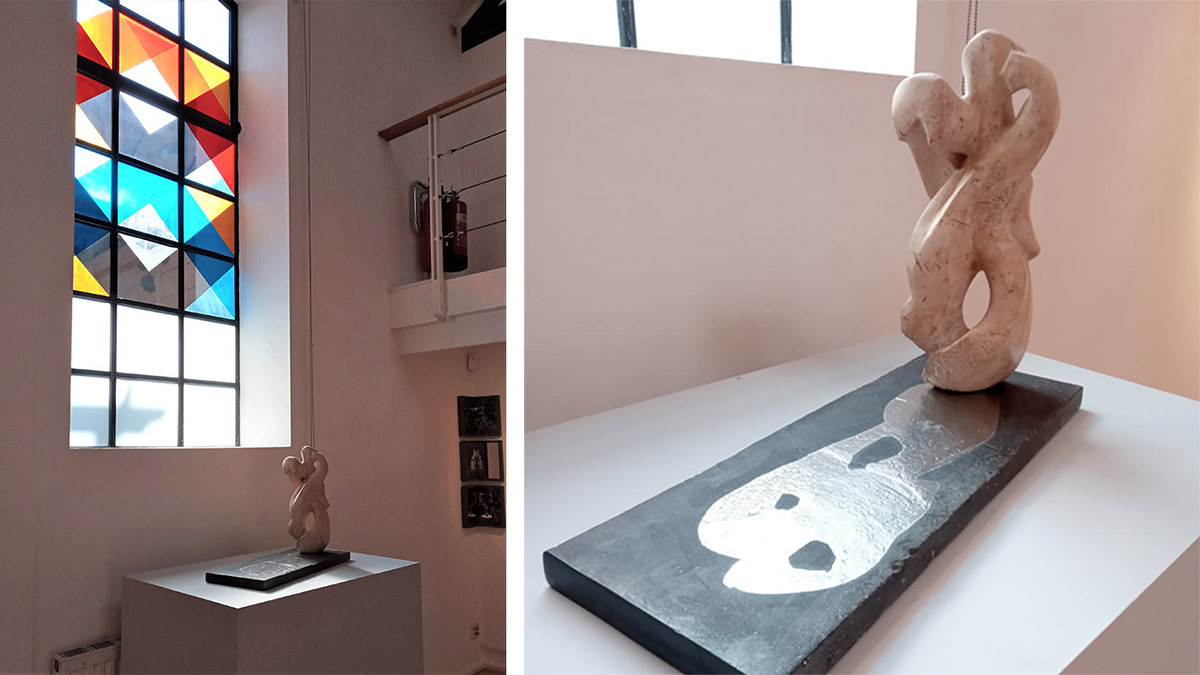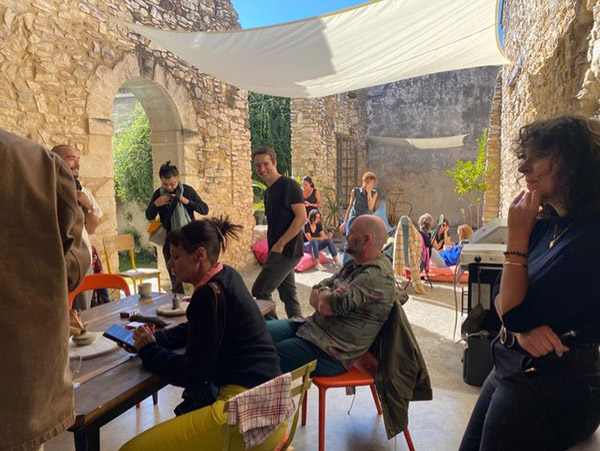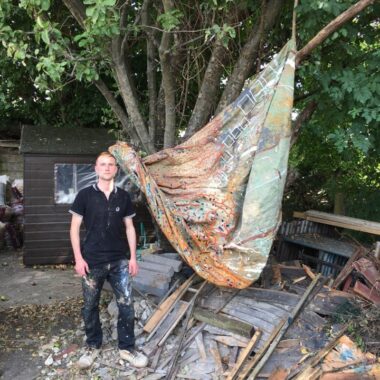“stimulating environments with vibrant energies”
Members discuss their experiences. With a foreword by Mike Phillipson LG the newsletter’s resident wandering word-grabber.
Members’ experiences of residencies span the globe. Ranging from the very brief to the extended (occasionally even the repeated), they have been welcomed as generous charities offering sustenance, place, and time in an ‘elsewhere’ that feels more like a mini version of Kafka’s ‘destination’ – the infinitely distant “Away-From-Here” – than the place where each of us does, in the contemporary sense of ‘to reside’, actually ‘dwell’. Derived from the Latin verb for ‘to remain seated’, ‘to reside’ seems aslant from the wide range of movements likely to characterise most artists’ residency experiences. Given that some residencies make no demands on their artist-beneficiaries and have no explicit expectations of outcomes, remaining seated is just fine! But other granting organisations have both hopes and expectations that look forward to their residencies as sites of hoped-for exchanges. These might include a small exhibition of work(s) completed or in progress at a residency’s conclusion, open-studio events, some teaching responsibilities, social interaction with other artists sharing the residency, possible responses to each organisation’s specific focus (its buildings, surroundings, local community), and perhaps some formal or informal contact with its employees or visiting public, and so on. Of course language differences between beneficiaries and hosts might make some exchanges difficult to achieve.
Given the defining unpredictability of making-for-art anywhere (no guarantee that anything will come out of the venture…), and given that visiting artists, as short-stay non-dwelling strangers, are unable to share the unique particulars characterising the world of the local in-dwellers, perhaps artist-beneficiaries inevitably find themselves suspended, just below residencies’ surface agreements, between participating and observing.
Might there be subtle pressures for the time of their short stay to somehow both appreciate, reconcile and respond to the complex (perhaps untranslatable…) nuances of ‘just living right there’, while necessarily remaining only ‘proximate’ to that ‘there’? Can one leave ‘home’ behind (all the baggage one carries everywhere including whatever it is that has shaped one’s commitment to make-for-art), while trying simultaneously to bring off a brief performance of making-for-art as if one does indeed dwell now right ‘here’ within the nuances? Probably not…
Members’ responses to the challenging complexities of the tensions of the gift of ‘residencies’ display a fascinating range of detours circumventing this tension. Further Newsletter contributions from members to the ‘residencies’ theme are welcome.
.
Cadi Froehlich
Redgate Gallery Residency, Beijing, 2015
The Red Mansion prize is awarded to a graduate from each London Arts University in association with the Red Gate Gallery in Beijing. I was lucky enough to be the selected winner from Chelsea and I decided to take the plunge and leave home behind for a month.
The program supports an international community of artists and provides a network comprising local mentors and workspaces as well as introductions to local artists and producers. Mainly, I think the aim is to increase cross-cultural understanding and cooperation, and for me personally, it was this international link which made up a large part of my experience.
Most artists are provided with a living and work space within an artists’ community on the outskirts of the city. Due to an admin mix-up, I was allocated a tiny hotel room which had the advantage of being in the city centre – although as someone who makes 3D work, which at the time was large scale, this was an immediate challenge.
Challenge followed challenge as I struggled to navigate a city which was on a scale I was somehow totally unprepared for. At the time the population was 22 million people, the transport network was in development following the Olympics, and most of the signage was impenetrable to me. I had thought I was well-travelled before I went to Beijing, but I quickly realised that the northern hemisphere I visited was a hegemony compared to this glimpse of another way of living.
This sense of alienation and disconnection from my familiar was strange and made even stranger as the ‘umbrella protests’ were occurring in Hong Kong which led to the authorities shutting off the internet for 24 hours.
The shock of realising how far away I was, how dependent I have become on technology to navigate, communicate, create and generally orientate myself came rushing in. Without the means to research suppliers, connect with other folk there or back home, or even translate a simple word was really hard, but as it turns out it was really formative in my practice.
The human face-to-face, the physicality of sharing, the sensations of smell, sound and air (all of which were at times really challenging to this asthmatic in the smog of that city) have continued to inform my practice, and I am still trying to convey this wonder and terror in my work.
This urge to communicate, to exchange, to feel the connection with a person, place or thing was distilled during my month away. The abundance of cables and the network powering my time there are the elemental themes I clung to.
The fragility and the scale of my work continue to evolve, perhaps influenced more than I realise by recent global and personal events, but I am indebted to that challenge in Beijing in 2015.
.Micheál O’Connell / MOCKSIM
Residencies, a word associated mainly with the so called art world, is one to get tired of. People do them in all sorts of institutions and non-institutions: a certain Ivan Pope I know became artist in residence at a dump. There’s an inclination for people to complain that residencies only suit those with no responsibilities and no strings attached, and that this works against the illusive ‘inclusiveness’. Now that my offspring are old enough to not want me around much though, I appreciate having been able to get more of this residency action in recent years. I do not see them as an end in themselves though, nor as a sort of weird holiday, but as a means to work (hard) in a different setting. Adapted from here: uillinn-mocksim.blogspot.com
[fvplayer src=”https://youtu.be/2IXOcQ5r5UY”] .Claire Parrish
Wilhelmina Barnes-Graham Trust 2014 Artist Residency, Balmungo House, St Andrews, Scotland
Fresh out of college, my approach to this residency was straightforward: I’d quietly develop my settled work for a few weeks, and have something at the end to put on my new CV. Job done, I thought. Of course, reality turned out to be a bit different. After two weeks, I left with work I hadn’t thought possible for me, and understanding why living and working in the same building isn’t for everyone. It’s a shame I had to go all the way to Scotland to find that out, but hey.
Wilhelmina Barnes-Graham inherited Balmungo House in 1960, and she divided her time between Scotland and St Ives for the rest of her life. Before her death in 2004, she set up the Barnes-Graham Charitable Trust to give art students scholarships and bursaries, as well as residencies to develop their work. So apart from the 24hr use of her old studio and a luxurious suite of rooms above for me to stay in, I was given unlimited access to her library & archive, free run of the house full of her paintings and antiques, plus its 6 acres of private wooded garden. Even food and cleaning was provided. I put the house’s unsettling atmosphere down to a combination of my imagination and having the whole place to myself. I moved into the studio and got down to work.
For the first few days the novelty of being there was utterly seductive. I reckoned good work would surely follow from being in this environment: the large light studio was on the first floor at the back of the house, and I could gaze down towards the sea or mooch round the woods and garden whenever I liked. I had set up the same found-plastic assemblages that always previously got me working at home, surrounded myself with familiar inks and papers. Although I kept working away, I started to feel that whatever I made looked a bit flat and diminished somehow. I kept calm and carried on – I was bound to work my way through this. But by day 5, I sensed the jig was up. Things weren’t coming together and I couldn’t work out why. I had to do something.
Disheartened by this turn of events, I set off on an absent-minded tour around the house, ending up in the attic rooms. I opened one door, and wham, it was like being caught in an ice-bucket challenge, the hairs on the back of my neck prickled right up. Maybe it was too much cheese at lunch or something, but I shot downstairs pretty sharpish and went out into the garden.
Wandering around outside, I found the bonfire site where charcoal and ash had been left after the Rhododendron clearing. I filled pockets with damp burnt wood and ash, pulled myself together and headed back to the studio. The response was pretty instant: working directly with what I’d found, smearing and pushing it around the paper surfaces felt utterly immersive and intoxicating. Did I imagine or sense the shift in the house’s atmosphere, who knows? But for the rest of my stay there, I settled down to happily produce dozens of new drawings.
Looking back, the residency pushed me right out of my comfort zone towards a much more experiential relationship with materials. Mine was the last residency to take place in Balmungo House, so the trust kindly let me have some of Wilhelmina’s old art materials and paper. I’m now down to my last few bits of rhododendron charcoal, but they still come out occasionally if a drawing needs loosening up.
.
Chris Horner
I have just begun an 8-month residency at Farnham UCA. It will be an exciting time as I intend to create a new and challenging body of work. I will also have the opportunity to share ideas with the current students, tutors and technicians. I am also looking forward to having the chance to teach the BA and MA students through a series of crits and group seminars. I did complete a residency in February 2019 at the Old Diorama Arts Centre, London. It was a memorable time and I am sure this time round will be no different.
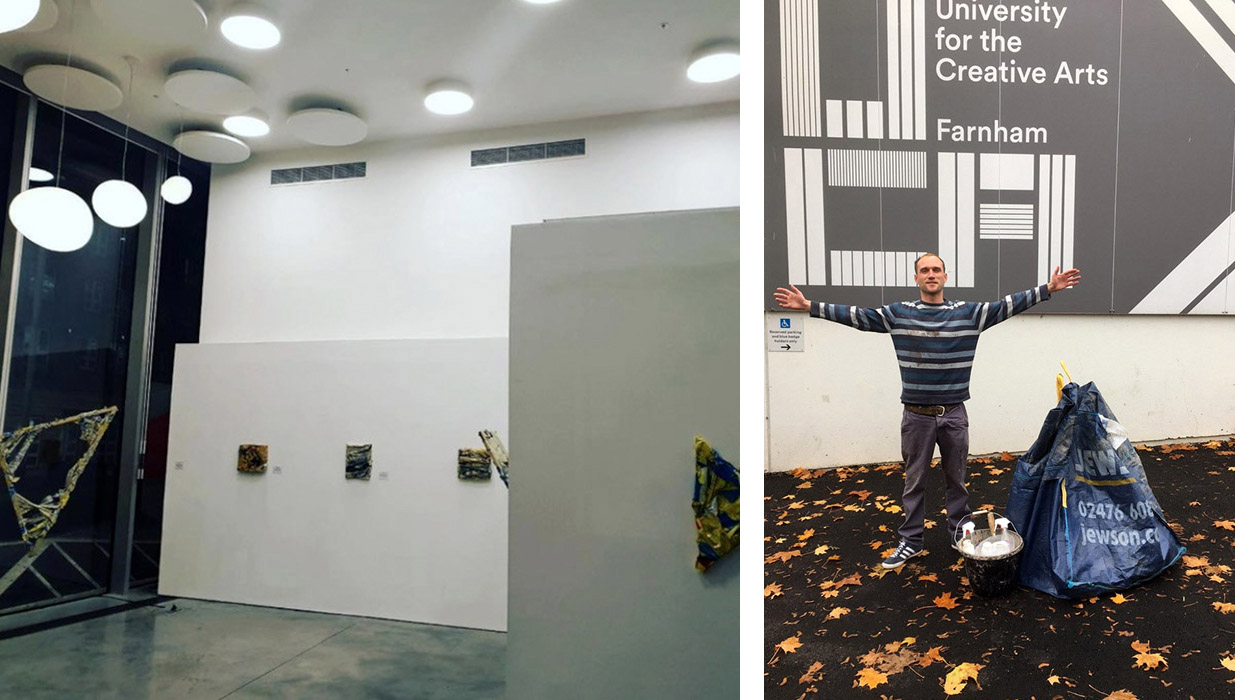
.
Susan Wilson
In the 1990s I was shortlisted to direct the Winchester School of Art studios in Barcelona. I was visiting tutor to that great city and I talked to the awardees. What bothered me is that the students seemed to be making work that was based in the UK and were not engaging with the Catalan culture. One Scottish student was the exception. At the time one of the great Catalan singers Lluís Llach was performing and I asked each student if they would go to the concert. They hadn’t heard of him, and he symbolised the enormous rapid post-dictatorship changes which were happening all around them. Barcelona between Franco’s death in 1975 and the time of my visit was an astonishing, rich cultural moment. Sardanas were danced all over town and Catalan which was a banned language was being spoken again and rapidly, taught in schools. This underlined for me the problem of studio-based residencies. They are superb on your cv, it all looks good, but does development result?
In 2014 I went to Pignano Near Volterra, for one which lasted two weeks. It was lovely but on reflection I consider more time is needed to familiarise yourself with a new place, to figure out what to do. It was beautiful, the studio quite wonderful, but it left me thinking about studio practice. The big shock of this time was that I painted a small portrait of my husband at night and as it evolved I saw, directly in the paint that he wasn’t well. Painting a portrait from observation can be very revealing, even shocking. I could see he had Parkinsons. He did not have other symptoms.
In 2019, I rented a studio at The British School in Rome for a month. This was for August, and once again I wanted to make new work, do something new, be different, and build for a change on my return to London. Did I? My previous stay meant living on a mountainside and once in Rome at the BSR I said I didn’t want the studio, I wanted to be in Rome every day, all day with my sketchbook. That, was best, no doubt.
With both these residencies I was able to take my husband, now very disabled with Parkinsons, and my dog, who assists us both. I’m extremely grateful to the BSR and to the Royal Drawing School for this most generous decision, and I think that we need to be able to take children too, with us, if possible. It’s extremely good for them, and not impossible to get work done with them alongside. Children need rich experiences too.
Otherwise, I rarely apply. I never want to use a studio away from my London one, and If I go away I’m keen to draw, look, watch, make notes, and take in as much as I can.

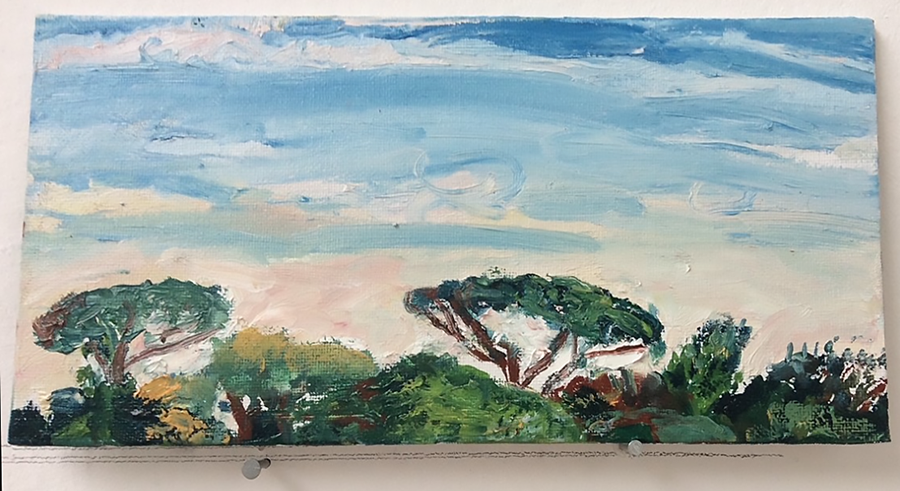
.
Genetic Moo
Exploding Cinema
We’d been showing films and enjoying Exploding Cinema for years – a “volunteer collective of filmmakers and cinema fans who believe in maintaining an open access screening where anyone can show films regardless of subject matter, taste or filmmaking ability”.
We loved Exploding so much we made them an offer – we would be their resident artists, (they’d never had one) providing projected artworks to add to their mix for free. We would point our webcams at their films, parasitise and remix the visuals onto a side wall. In exchange, all they had to do was list us as resident artists, which at the time upped our CV. They thought it was a daft idea, but as it didn’t cost them anything they agreed. So for about a year, we added live interactive digital components to their shows – for example, a hoard of digital slugs would respond to a film about contemporary politics.
Sometimes it worked, sometimes it didn’t. At its simplest, we were both projecting cool stuff onto the walls.
Our residency ended, but Exploding Cinema carries on. Years later we invited them to Margate to fill the old Woolworth’s building with film projections and generative art. They even did their own interactive with some fish on sticks.
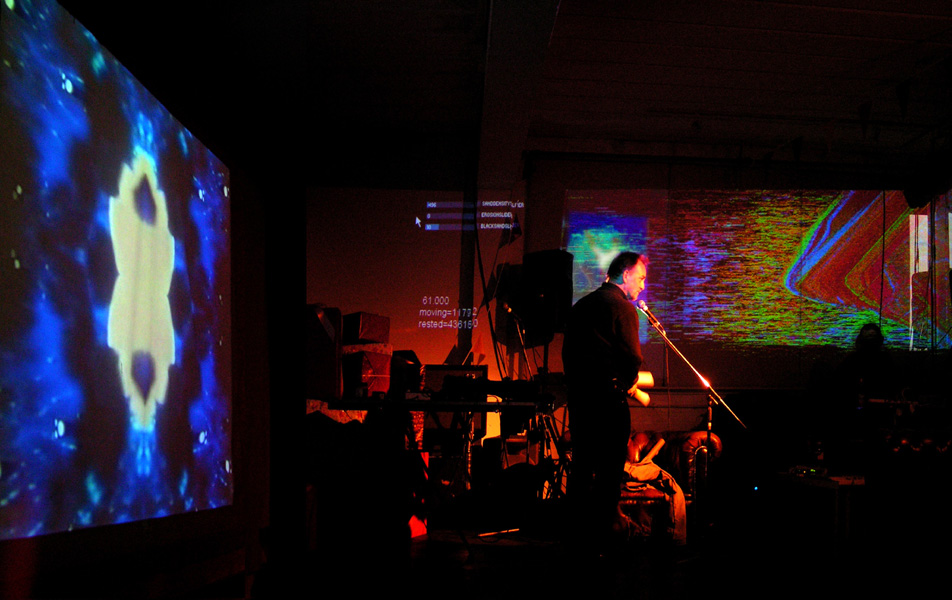
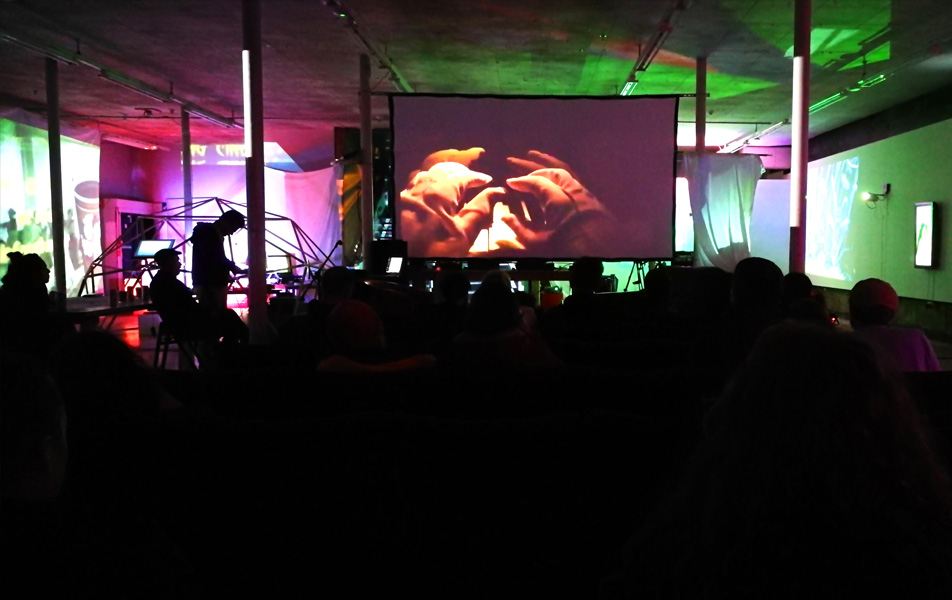
.
Clive Burton
Studio 7 Calle Nueva Polopos Granada Andalusia Southern Spain
A Residency 3 times x 3 weeks annually, curently reoccuring
‘Un Relato de el Pueblo’ (A story from the Village)
An on going developing, changing, adding, Intervention Installation in Serial Progress
A Visual Experiencial Story, Poem, Building and Enviromental Verse;
Verse in Transit and Marriage from the Past into the Now
The Collision and often Surreal Intercourse of Objects, their Environment and Spiritual Presence
Changing with the Visits leaving ‘Now’ Real Moments to become the Virtual Past
‘All Worlds are Virtual, Reality is Variable’ (quote Roy Ascot 2022)
.
[fvplayer src=”https://vimeo.com/780295155″ height=”540″].
Amanda Loomes
Dorking
In 2010, along with three other artists, we undertook an Arts Council England funded residency in our home town. Between us we had lived in Dorking for 106 years. The ‘residency’ challenged us to alter our perspective and see beyond habit.
I developed a community art project on a large council estate, which lies hidden behind one of the Surrey Hills. The Estate had been built in the 50s to house workers in the brick industry. Finding ways to put art to work by combing community engagement had a profound impact on my practice that reverberates today.
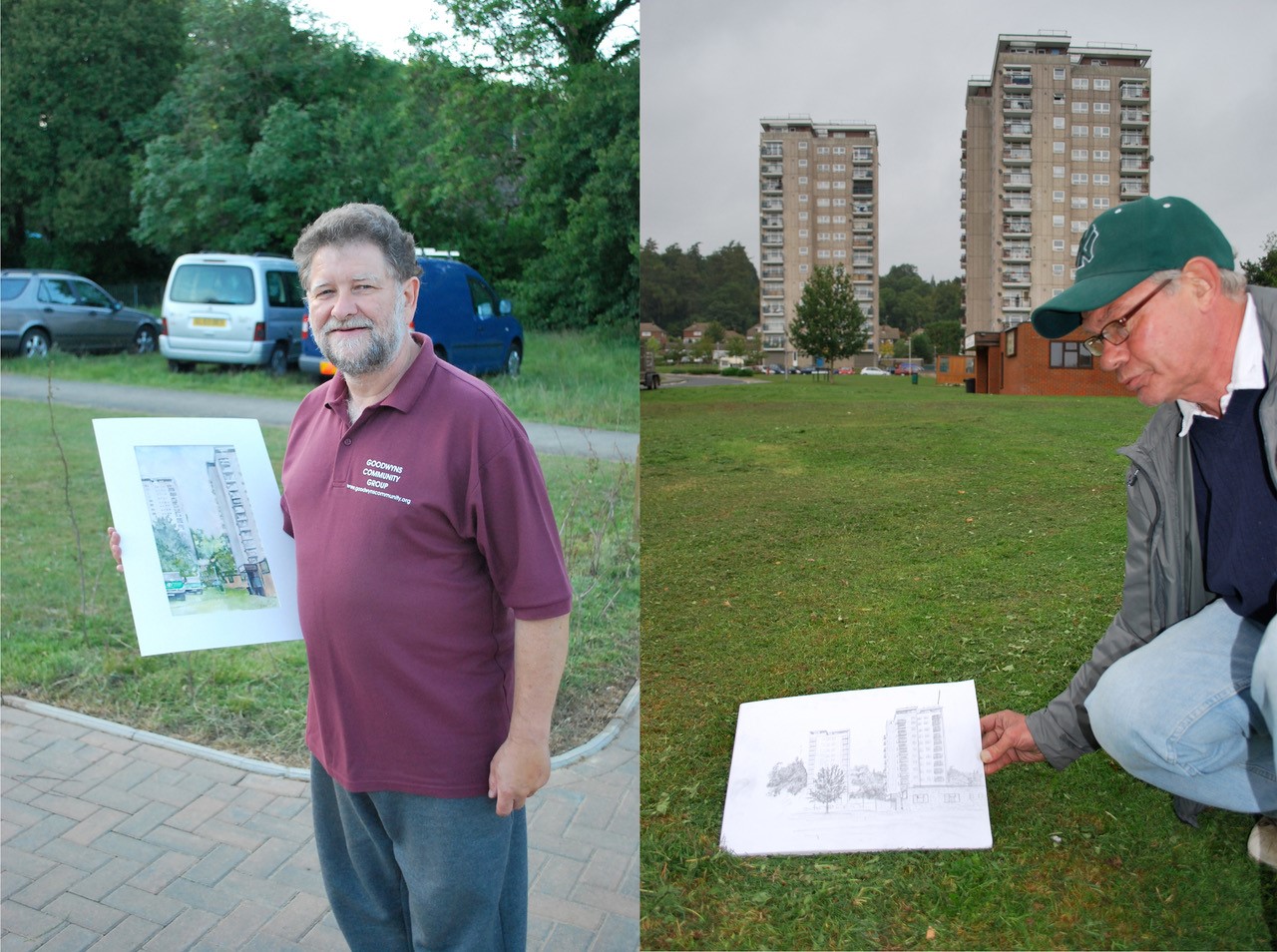
The image above shows a member of Dorking Group of Artists proudly displaying a sketch made during a summer outdoor landscape painting session and the presentation of a painting to Barry Davies upon his retirement after 25 years as caretaker of the tower block, Wenlock Edge.
I made the film Equivalent I – VIII which can be seen here
[fvplayer src=”https://vimeo.com/17612461″].
Julie Held
The Picker Fellowship
I applied for The Picker Fellowship as I thought it would be wonderful to have my own studio and be paid too on leaving Camberwell in 1981. I also thought it would be a long shot should I get it that year because hitherto it had been open to Post Graduate Students only. To my delight, I was appointed as The Picker Fellow and began my tenure in September 1981.
I must admit that I felt a fraud when I first sat in the Staff Room during the morning break on the first morning and was seen as an equal there. These coffee breaks proved to be a great plus in my life there as I met some inspiring and inspired artists, Adrian Berg being one of them. He went on to become someone whom I considered to be a friend until his death. Adrian was a beguiling and irrepressible raconteur, his fruity and vivid tales were often hilarious and drew a vivid picture of his many adventures, not unlike the Ancient mariner in Coleridge’s great poem. I was mainly shown great support by the staff in the Fine Art Department apart from one! He was aggressive, bullish and rude to me which at the time I found hard to deal with and troubling.
My teaching obligations (a few hours a week) weren’t plain sailing at the start, as the students I was assigned to considered that as we were almost the same age, I couldn’t have anything of worth to say to them. This was unlike my teaching at Camberwell on Saturday mornings with local sixth form students; a class I had been given on leaving there in that summer and loved. So the contrast was hard at first.
I found my time as the Picker Fellow helpful by and large and having the structure of working towards an exhibition of my work made at Kingston at the end of that tenure a good goal. That year was not without its challenges: a mixture of comradery and isolation. isolating in that I was not a full-fledged member of staff there whilst at the same time, not a student either.
It was a stimulating environment with vibrant energy of multiple departments: fashion, product design, architecture and of course Fine Art amongst others too. The River and town itself, leafy and beneficial too.
I left more confident than when I arrived and also more aware that vacillating between confidence and uncertainty in one’s work is the normal balance for most creatives.
.
Mary Branson
HMP Send Women’s prison
Residencies are my preferred way to work. I feel that if I can spend time with a community, study the space and unearth its history, I can produce stronger art.
A residency that stays with me is the year I spent in HMP Send Women’s prison. I went into the commission with naïve assumptions and came out with insights into our criminal justice system and the women it holds in custody. It enabled me to make an artwork that felt honest and informed. The work was commissioned and exhibited by Watts Gallery in 2014. marybranson.com/containment
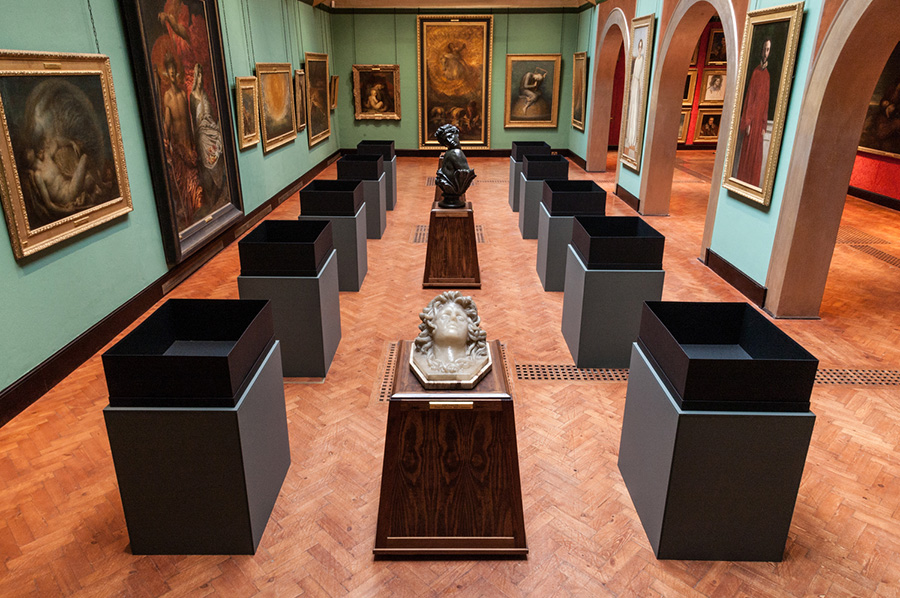
.
Paul Tecklenberg
New York Historical Society
In 2019, I was invited to be an artist-in-residence at the New York Historical Society as part of a planned exhibition, ‘On The Waterfront’, curated by Maddy Rosenberg due to take place on Governor’s Island that year. For some reason, I procrastinated with booking my flight from London and then the pandemic struck, putting everything on hold. At the time, my practice involved experimental analogue photography, where I made photograms as well as the occasional sculpture. During the lockdowns, I had no access to a darkroom so concentrated on making sculptures, kicking off with transforming a cement mixer into a globe by drilling a map of the world into the drum. I started to collect and quarantine ‘laughing gas’ bulbs I found in parks and council estates in Peckham. During this time, ‘Jacob’s Ladder’ and ‘Safety Net’, made from laughing gas bulbs, were selected for the Royal Academy Summer Exhibition and was elected a member of the Royal Society of British Sculptors. My practice had been transformed and I began to see myself as a sculptor, rather than a photographer. Maddy got back in touch about the residency so I went to New York in September and started my research.
Governors Island became the dumping ground for the spoils of digging out tunnels for the subway system. The island is now three times larger. When I was there, I began to grasp that New York is a coastal city, more like Liverpool than London. This is easy to overlook when you are in the heart of Manhattan. To get to the island, you must catch a ferry and as I did, I was struck by the navigation buoys that resembled plastic bottles. Inspired by this, I cast still and sparkling water bottles out of concrete and attached photographs of the Hudson panorama onto them. The bottles are meant to be hung at various angles, indicating the movement of buoys impacted by the tide as it goes in and out. I am also casting milk bottles in plaster which will indicate different tides. I now realise that I have gone full circle, having made a ‘beach’ out of 140 milk bottles with photographs of Blackpool beach and Sellafield nuclear power station stuck onto the sides for my degree show.
The exhibition, ‘On the Waterfront – A View From the Coast (Line)’, will be on show from 1st March until 23rd April at Central Booking at BWAC, 481 Van Brunt Street, Red Hook, Brooklyn 11231. The show is curated by Maddy Rosenberg and includes Desirée Alvarez, C Bangs, Elena Berriolo, Sabra Booth, Graciela Cassel, Margaret Craig, Steven Gawoski, Judith Eloise Hooper, Helena Kauppila, Diane Lavoie, Ellen Levy, Patricia Olynyk, Maddy Rosenberg, Susan Rostow and Paul Tecklenberg.
For further details contact Central Booking at cb@centralbookingnyc.com or visit www.centralbookingnyc.com
.
Anne Leigniel
A lot of my work is triggered or inspired by my surroundings. For that purpose, residencies are fabulous opportunities for me to work In different environments with different people and often in various cultural codes, equipment …
Residency is also a given time during which we can totally focus on our work. Reading writing thinking, working throughout the night, or not working at all…it is a gift made to our work to be 100% focused on it! (or with a different focus )
I usually try to put things on hold until my return.
The residencies I have been to have never been for longer than a month so far. And I don’t feel the need for an extended time for the time being.
My favourites
Échangeur 22 in France near Avignon
In 2015, I did a month in their “Residency Mobility “ a program with artists from France Japan and Brazil in St Laurent des arbres and then in Rio in 2016
We’ve developed a close friendship and I have met many artists through them
I go back for a few days or special projects quite often
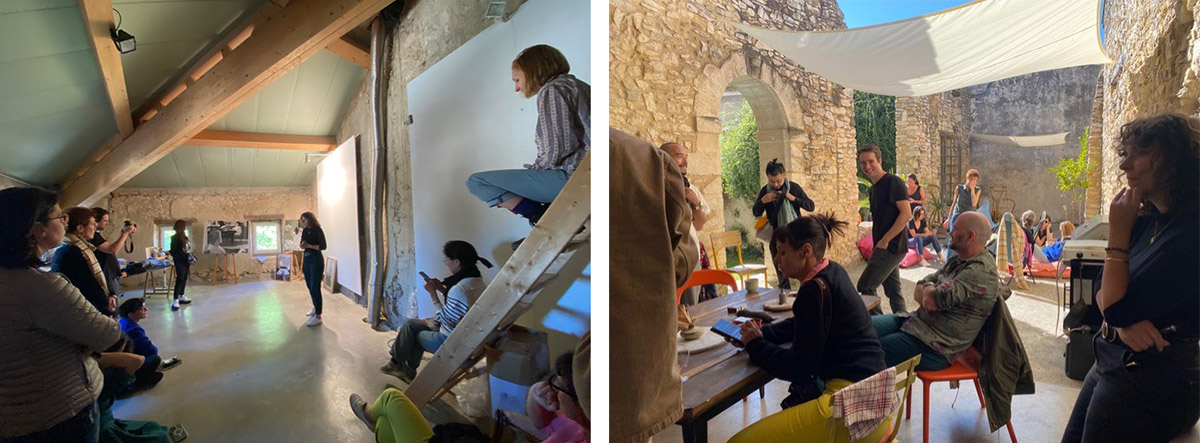
Convento de st Antonio in Chamusca Portugal
Once with a writer
Once partly with a visual artist
A very informal residency with extremely little funding in a marvellous old cloister and an amazing view
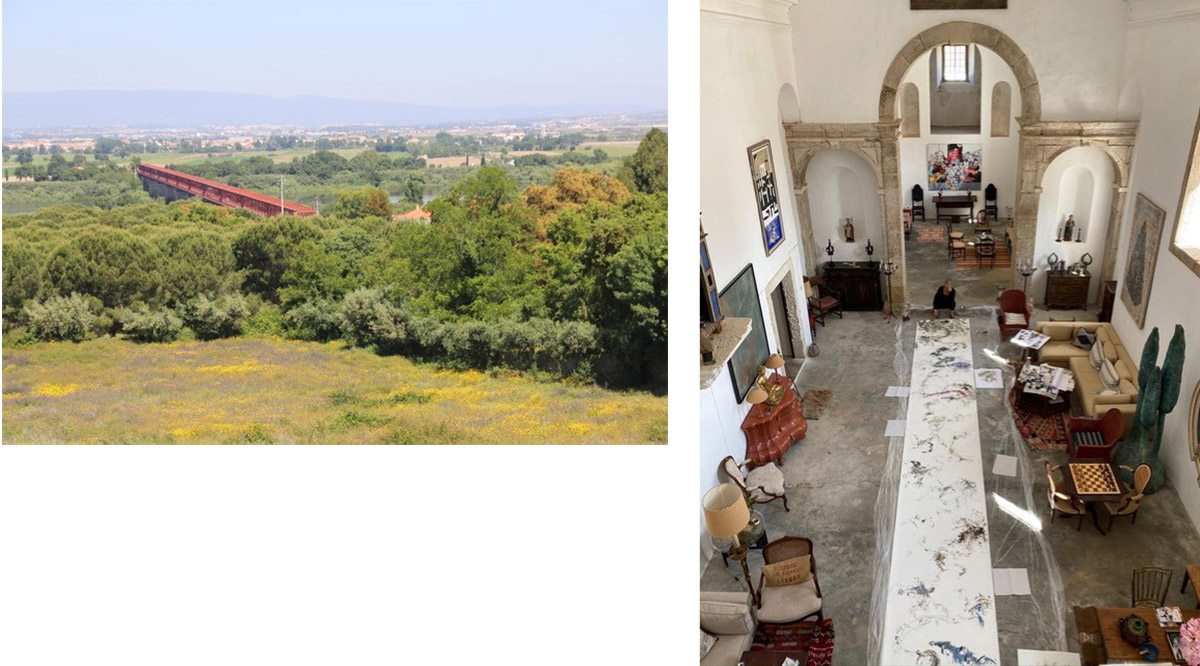
.
James Faure Walker
Nova Scotia College of Art and Design, Halifax, Canada, 1982; Phillip Institute, Melbourne, Australia, 1983; Columbus College, Georgia, USA, 1996.
I was more a tourist than an artist-in-residence. Sometimes I could blend, other times I felt out of my depth. In Columbus, Georgia, there was the Bible Belt. A lecture on Egyptian Art was interrupted: “Sir, that was before God created the earth.” The painting tutor demanded total darkness for his talks, where he would reveal the secret of good painting: the finest Italian shoes, no socks. At NASCAD (Nova Scotia College of Art) I stayed in a timber frame apartment by the harbour, with clam chowder at the Blue Nose cafe nearby. Previous residents included the leading lights of conceptual art. It was a great school. The city of Halifax had been reshaped by the catastrophic explosion of a munitions ship in 1917. Painting was a modular course, and pragmatic. One morning the students marched in each carrying a long mirror: the full figure self-portrait made in a day. In Melbourne I worked alongside the students, and it was difficult not to be self-conscious. I was there with John Bellamy. We had been invited out by Jeff Makin, who had worked alongside Fred Williams. I learned a lot about Australia, how to read the landscape – not as easy-going as the Cotswolds. After completing a lecture tour, I got to the Barrier Reef.
Thirty, forty years ago you had to travel to overcome your cultural cringe: New York, Paris, London were at the centre, the sources of art wisdom. I might feel a provincial in New York, but in the remotest colleges, far from any art metropolis, it was the other way around, and I was stuck finding the right thing to say: what did my colleagues in London think about their work? Before the internet, before international art fairs, it all flowed from exhibitions and art magazines. And that was just the English-speaking world. I was lucky. These ‘residencies’ were blissfully free of any obligation to spread creativity through the community. I was the one learning, taking it all in. But perhaps that could be true of all residencies.

.
Sumi Perera
Living a nomadic life since the age of 3, born in Sri Lanka and living in many countries, I have occupied a liminal space and gained a multi-cultural identity. This quality has been further enhanced by some residencies in Beijing(2007), London(2016), Venice(2017), Marcilhac-sur-Cele (France 2017), Yinchuan (China 2019), and another at the West Yorkshire Print Workshop, Mirfield UK (dates TBC).
The residencies, have allowed me time to reflect and create new work. I exchange skills with fellow artists, have taught, learnt, collaborated, networked, made site-specific work using local materials to produce interactive variations on the theme. The work usually is flat-pack, which can expand, mutate/transform reversibly to return to the original state. www.thelondongroup.com/state-of-residency
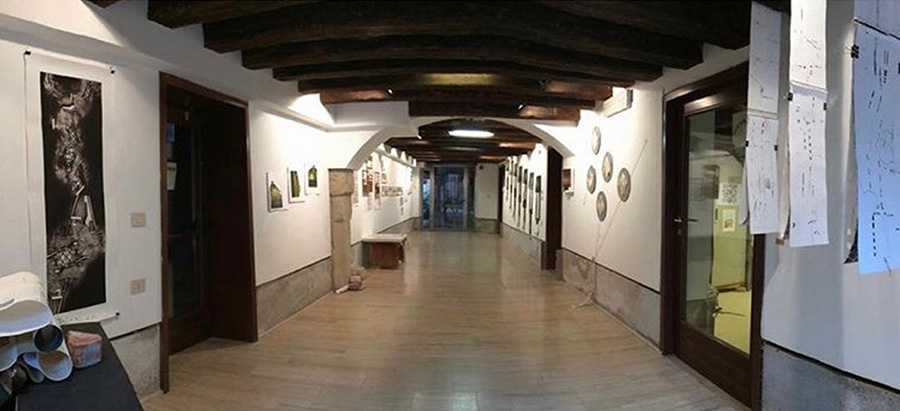
.
.Lisa Traxler
Art Space, Portsmouth, UK
In 2008 I was awarded a studio residency at Art Space, Portsmouth, UK. It was a two-month residency whereby I was given the key to a wonderful studio. It was a place I could retreat to every day – a space from the outside world with the two months ahead of me to engage with the space, meet the other artists in the building, find new ways of working and have TIME.
Art Space Portsmouth is a creative hub for visual artists and visual arts activity in the Portsmouth and South East Hampshire area. It was formed in 1980 by graduates from Portsmouth Polytechnic. The building itself was a former Methodist Church built in 1905. Its function as a church ceased in the 1970s and the building was leased, via Hampshire County Council by Portsmouth College of Art & Design, as an extension to its campus.
The history of the place drew me in and was a platform for me to explore new works. The first couple of weeks were daunting, and to be honest, slightly uncomfortable! I had a near-empty room (a desk and chair) – studio 22. This paring back to the bare minimum was a revelation. I was forced to explore outside my comfort zone. I walked the area, took my sketchbook and camera everywhere and just took each day as it came. Gradually, ideas and actions started to flow and it was not just the physical space that was important but head-space, time! I felt permission to ‘play’ and it was exhilarating.
The residence culminated in a solo exhibition in the gASP gallery. The impact this residency had on me was dynamic. A wonderful experience which really was the beginning of my 3d works with stitched collages and photographs (as seen in the image). This artwork, the first of the ‘Paperscapes’ evolved significantly within my practice over many years and iterations of it were exhibited in many galleries and exhibitions. www.artspace.co.uk/artists
.
Alexandra Harley
I know that Covid was a really difficult time for all of us and at the start of lockdown I began planning and applying for crop picking jobs to raise ££. When I heard I would get furlough I was delighted, I went from despair to having the best ‘home residency’ possible. My studios remained open throughout which gave me time to reflect and consider; not something I can do often enough with my usual busy schedule. I enjoyed the slower pace and the time to test out ideas; spending time drawing proposals and developing ideas for the time we opened up again and, most importantly for me, finishing work completely. I also kept in touch with other sculptors, picking their brains and sharing images for feedback. Despite all this extra time, somehow, I never managed to complete the ‘to do ‘list.
